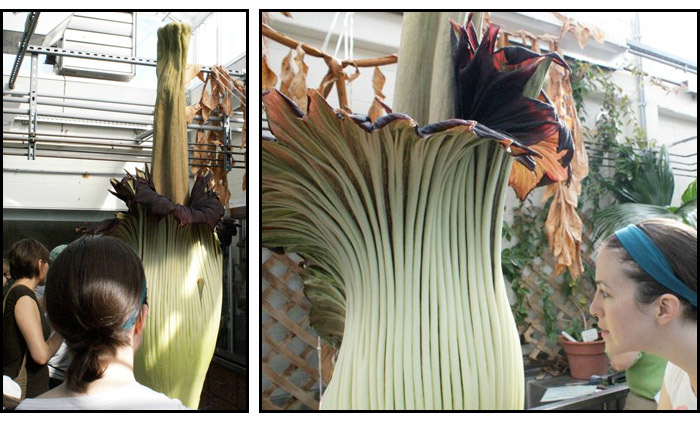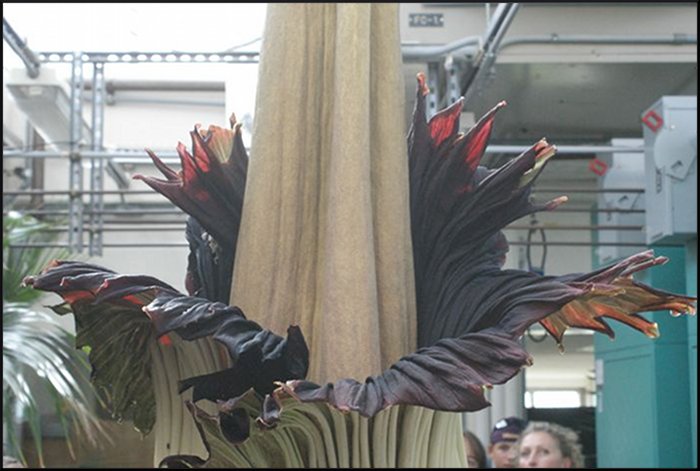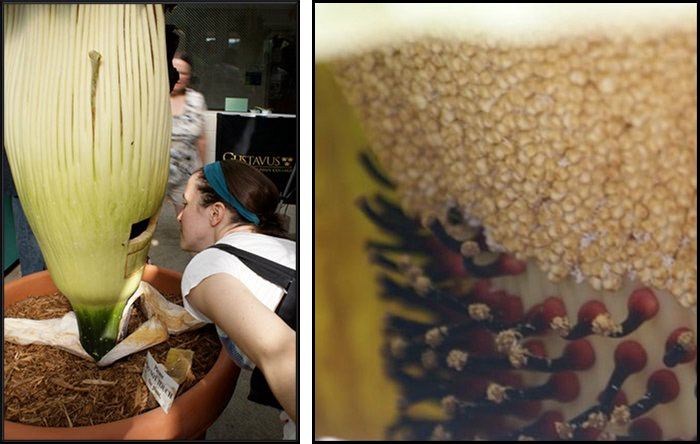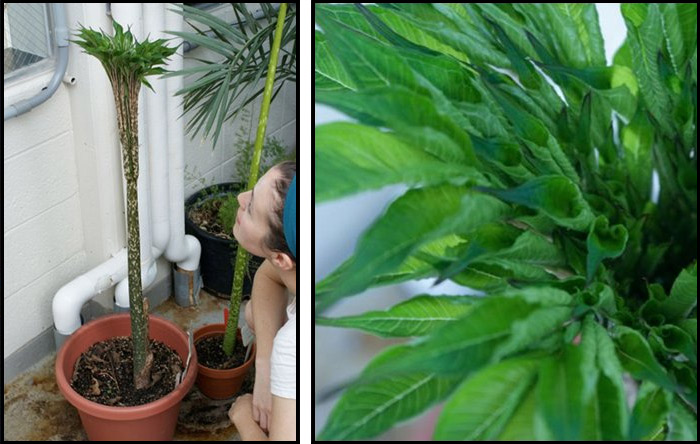Titan Arum: The Corpse Flower
Amorphophallus titanum
The largest (unbranched) flower inflorescence in the world
The prize for the world’s largest flower can be given to one of many different plants, depending on how you classify flower. Technically the plant with the largest flower is the parasitic Rafflesia arnoldi from Indonesia. The absolute largest flowering inflorescence is the massive terminal stalk that shoots out of the amazonian Talipot palm (Corypha umbraculifera). But, the largest, single, unbranched inflorescence goes to the Titan Arum (Amorphophallus titanum), and it is truly an amazing sight to behold.
What’s in a name?
The scientific name for the titan arum is Amorphophallus titanum. Its roots are Greek: Amorphos meaning “without form” or “misshapen,” phallos meaning “penis,” and titan meaning “giant.” To explorers trekking through the hot Bornean jungles, the phallic figure of a blooming titan arum may have looked a bit like a misshapen, giant penis. The common name, Titan Arum, refers the fact that it is an giant arum, the name given to members of the family Araceae.
How does the titan arum attract pollinators?
Like the largest single flower, the Rafflesia, the Titan Arum emits an unmistakable corpse-like smell. It attracts putative pollinators, such as carrion beetles and blow flies, that might be looking for a piece of a carrion. A combination of the smell and the heat released by the arum creates a strong attraction for these insects.
Background
The Titan Arum was discovered by Odoardo Beccari in Sumatra in 1878. Corms weighing as much as 100 pounds with a half meter diameter were brought back to botanical gardens. Yet the plant has bloomed very few times in the gardens, and when it does flower, the nearly six-foot yellow-red stalk lasts for only three to four days.
In 2006 a rare botanical flowering event occurred where three Titan Arums flowered at the same time. A study by Barthlott invedstigated the heating of the central column. He showed that the central column would heat up in pulses originating from the base and reach a temperature of 36 degrees. The following is a picture from that study.
References and Links
- Gandawijaja, D. Idris, S., Nasution, R., Nyman, L.P. and J. Arditti. Amorphophallus titanum Annals of Botany 51: 269-278, 1983 © 1983 Annals of Botany Company Becc.: a Historical Review and Some Recent Observations.
- A torch in the rain forest: thermogenesis of the Titan arum (Amorphophallus titanum) titanum Plant Biology, 2008
Crew stories
Suze Roots visits a blooming Corpse Flower at Gustavus Adolphus College, July 25, 2010.
I visited Gustavus Adolphus College in Minnesota to see an Amorphophallus titanum, or the Corpse Flower, a rare plant native to Southeast Asia. There are only a few in botanical gardens and greenhouses across the country, so I was super excited that one was blooming close by.
The whole room reeked of roadkill! The Corpse Flower produces a sulfurous odor to attract fly and beetle pollinators.
This is not the largest flower in the world (that title goes to a member of the genus Rafflesia), but it’s the largest inflorescence, or cluster of flowers, in the world. This plant grew from a seed the size of a walnut that was planted in 1993. This is only the second time that this plant has bloomed in seventeen years because it takes a very long time for the plant to store up enough energy to produce such a large inflorescence! We got there just in time. The inflorescence only lasts about 48 hours. It was already starting to wilt!
The outer purple sheath is called the spathe, and the tube-like structure is called the spadix. Plants that you’ve probably seen that look similar from the same family (Araceae) are Calla lilies, Anthurium, and Dieffenbachia.
I just had to get a closer whiff! It’s amazing that one plant could smell so incredibly rancid! They cut a tiny window into the spathe so we could see (and smell!) the hundreds of male and female flowers. (Right-hand photo: male flowers above, female flowers below)
This is another Titan Arum they are growing. I’m looking at the single leaf that this plant produces. When it fully opens it will look like a little palm tree. A single leaf will last a couple of years. Then it will die and another will replace it. This process will continue for about 10 years until it finally flowers!
Scratch “See a Corpse Flower” off the bucket list! What an adventure!








































































































